The best home office monitors: Displays that get the job done
Working from home has gone from being a growing trend to a full-scale phenomenon: One recent Gallup poll found 1 in 4 full-time U.S. employees works entirely from a home office. There are many perks to a work-from-home arrangement, to be sure, but there can also be downsides: For example, there’s a good chance you’ll need to supply your own monitor. Fortunately, there are many great home office monitors to choose from, and the most affordable models start at just $100.
Below you’ll find our picks for the best home office monitors, and below that you can learn more about what specs and features matter when shopping for a home office monitor.
1. Dell U3223QE – Best home office monitor
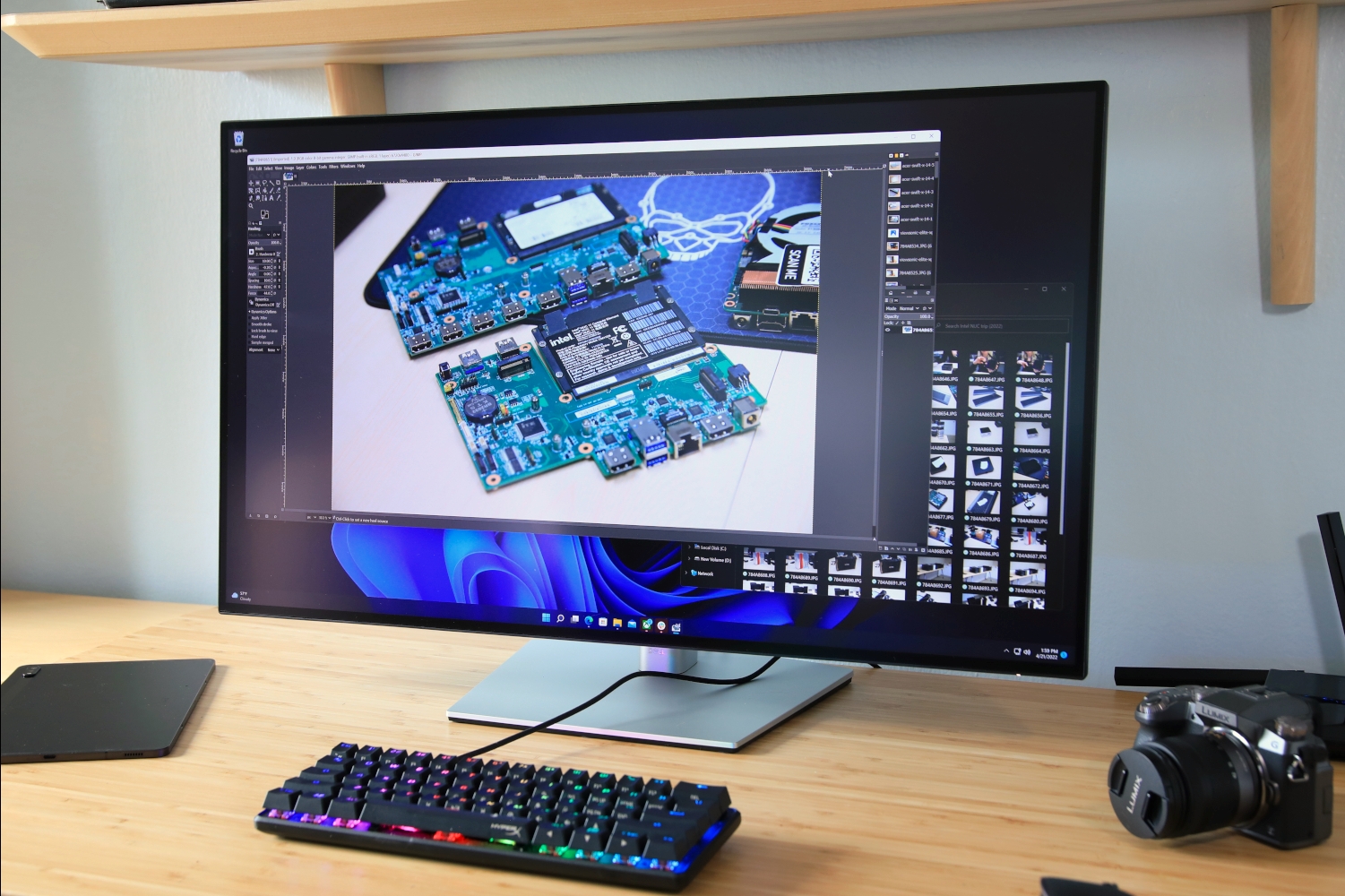
Pros
- IPS Black panel fulfills its promise
- Accurate color with wide gamut
- High brightness in SDR
- USB-C hub with 90 watts of power
Cons
- Edges of display are noticeably bright
- HDR performance disappoints
- Only a 60Hz panel
The Dell U3223QE is an exceptional home office monitor that will serve you well for a decade (or more).
This 4K, 32-inch monitor has superb image quality thanks to its cutting-edge IPS Black panel. This new panel type has roughly double the contrast ratio of a typical IPS panel, delivering a richer, deeper image. It’s also an extremely bright monitor with a maximum brightness of over 450 nits. Color performance is also top-notch with precise color accuracy and a wide color gamut spanning 99 percent of the DCI-P3 color space.
Home office owners will be equally impressed by its connectivity. This monitor has USB-C with DisplayPort Alternate Mode and up to 95 watts of Power Delivery for charging a connected device. When connected over USB-C, the monitor acts as a feature-rich hub with not only USB-A ports but also ethernet and DisplayPort-out. This monitor can replace a USB-C hub or dock on your desk.
The monitor’s ergonomics are great, too. It has significant adjustment for height, tilt, swivel, and can even rotate 90 degrees for portrait use—an uncommon feature for a monitor this large.
If the Dell U3223QE is too large, or expensive, consider its smaller sibling: the Dell U2723QE. This 27-inch 4K monitor has the same features and retails for a couple hundred dollars less.
Read our full
Review Dell U3223QE
2. NZXT Canvas 27Q – Best 1440p home office monitor
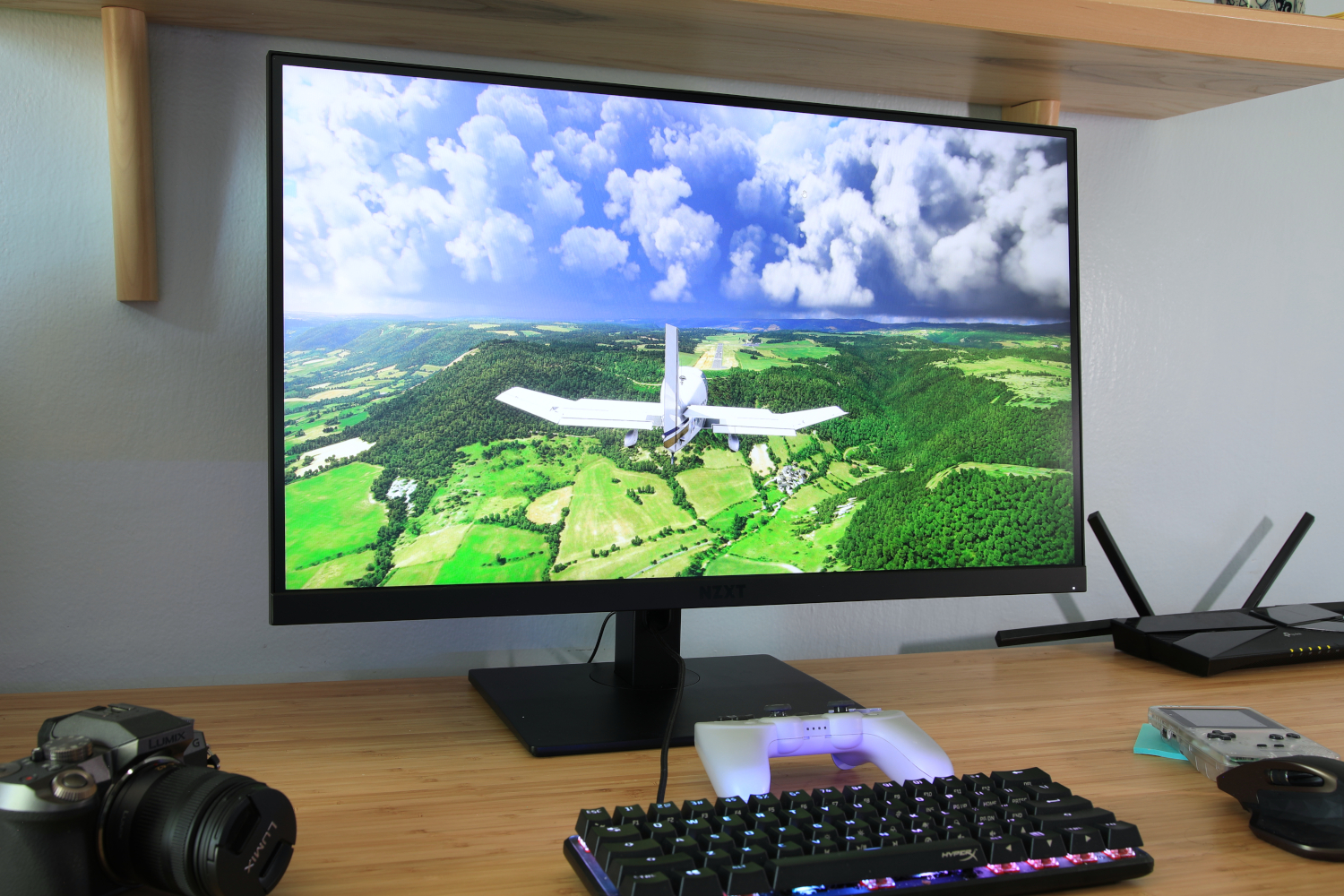
Pros
- Attractive and robust design
- Four video inputs including USB-C
- Great color performance
- High motion clarity at 144Hz and 165Hz
Cons
- Limited image quality adjustment
- Speakers not included
- HDR mode is barebones
NZXT’s Canvas 27Q is a great mid-range home office monitor and the best value pick on this list. It’s a smart choice if you want attractive image quality without spending a fortune.
The Canvas 27Q is a 27-inch monitor with 1440p resolution, which provides a nice boost in clarity over 1080p. This is a bright monitor, reaching nearly 380 nits at maximum brightness. It’s also color accurate and supports up to 97 percent of the DCI-P3 color space.
This monitor has a USB-C port with DisplayPort Alternate Mode. The USB-C port acts as a hub for two USB-A ports. Unlike most monitors, this one doesn’t come with a stand: The stand is a $40 add-on. It’s a great stand, though, with height, tilt, and swivel adjustment, and a sturdy feel. A $100 monitor arm is also available.
Want to fire up a game after work? The Canvas 27Q has you covered. It has a maximum refresh rate of 165Hz and supports both AMD FreeSync Premium and Nvidia G-Sync for smooth motion in games.
The Canvas 27Q has an MSRP of $339.99 but is often discounted to $249.99. The $40 stand brings the total price to $289.99. That’s excellent value given the monitor’s image quality and many features.
Read our full
Review NZXT Canvas 27Q
3. Acer K242HYL – Best budget home office monitor
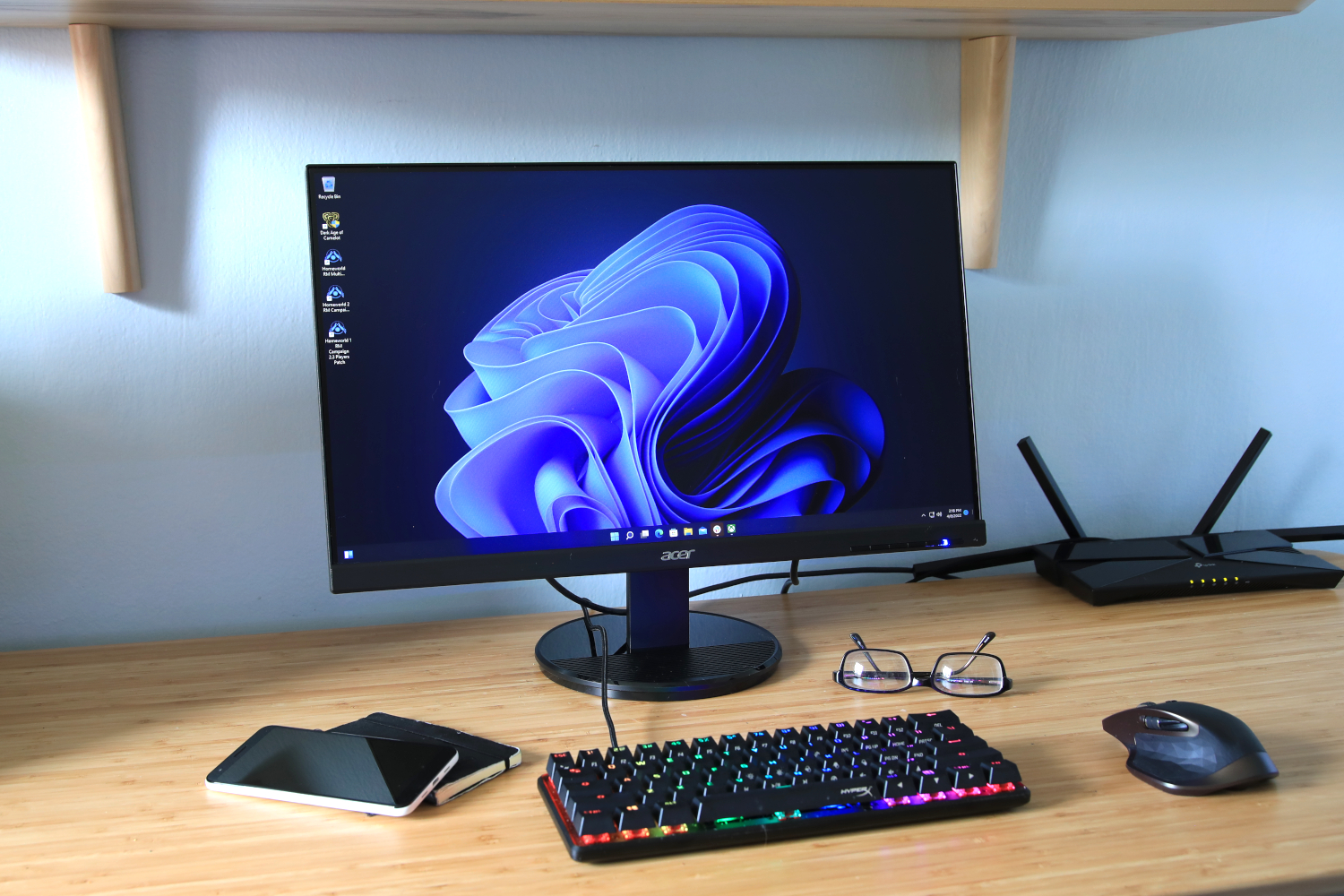
Pros
- Attractive color accuracy and gamut
- Acceptable sharpness for a 1080p display
- Avoids motion clarity pitfalls
- Menu system is easy to use
Cons
- Barebones design
- No height adjustment on stand
- Only one HDMI, no DisplayPort
- Power LED is very bright
Want a basic home office monitor that can handle most tasks at a very low price? The Acer K242HYL is it.
Acer’s K242HYL is a 24-inch, 1080p monitor. It’s not as sharp as a premium, 4K monitor, but image clarity is not bad for a monitor in this price bracket. The K242HYL also packs a respectable maximum brightness of almost 300 nits, good color accuracy, and supports 98 percent of the sRGB gamut. None of these figures are record breaking, but they’re great for a budget monitor.
The monitor lacks a height-adjustable stands, but this is common at this price. A VESA monitor stand mount is available for adding a third-party monitor stand. Video connectivity is limited to just one HDMI and one VGA. The monitor does throw in a few perks, though, including AMD FreeSync support for smooth gaming and a slightly enhanced 75Hz refresh rate.
Often priced at just $99.99, the Acer K242HYL is an impressive value. It’s the least capable monitor on this list, to be sure—but it’s more than adequate for document editing, accounting, project management, video conferencing, and hundreds of other home office tasks.
Read our full
Review Acer K242HYL
4. Asus ProArt PA279CV – Best 4K home office monitor
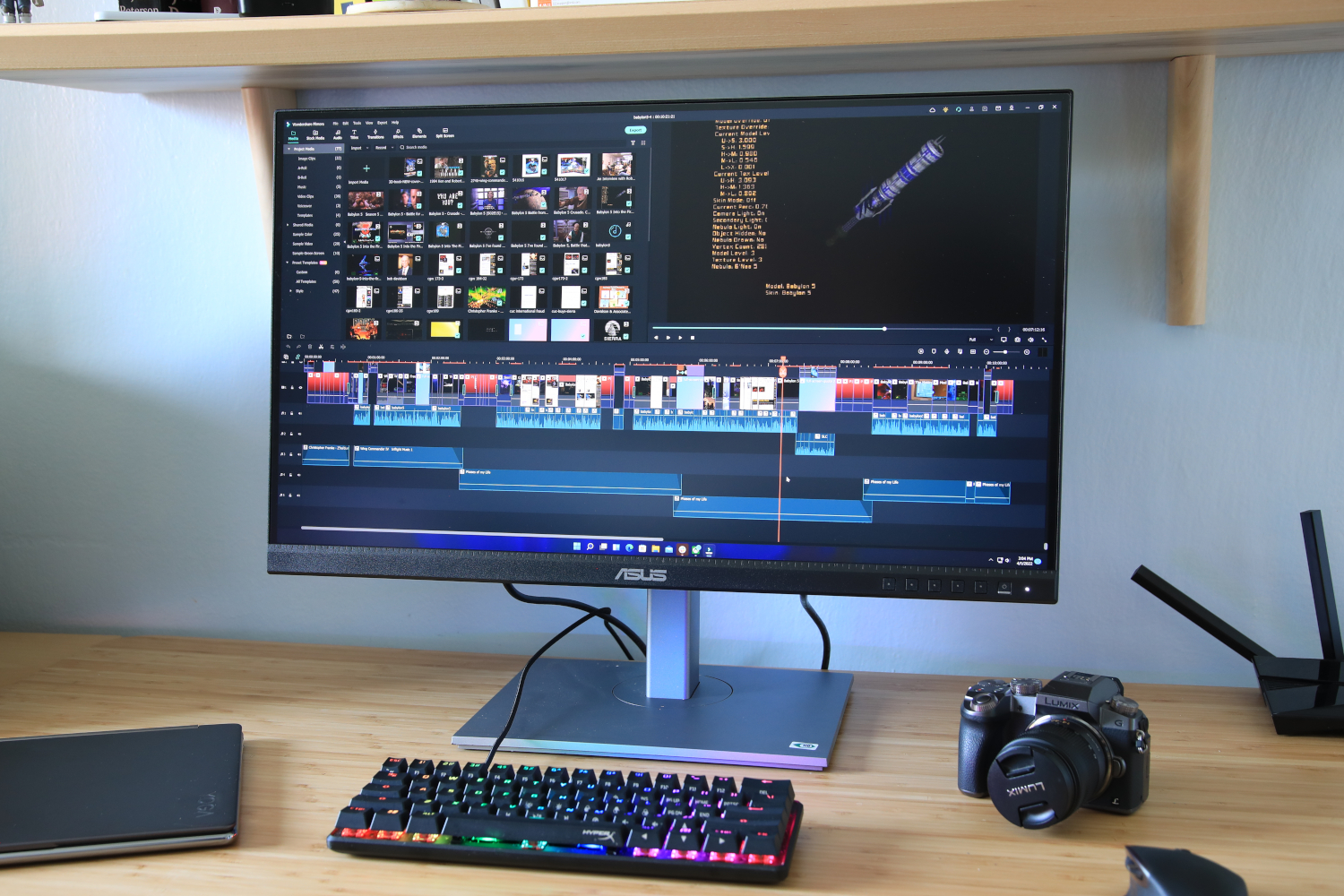
Pros
- Accurate image
- High maximum brightness
- Menu settings allow calibration
- Has USB-C with 65 watts Power Delivery
- Competitive price
Cons
- Unimpressive design
- Luminance uniformity could be better
- HDR is bright but otherwise falls short
Asus’ ProArt PA279CV is a great home office monitor that delivers many perks of our top pick, the Dell U3223QE, at a lower price.
The ProArt PA279CV is a 27-inch 4K monitor with excellent image clarity. It also has a superb maximum brightness of over 400 nits and very accurate color. It has a narrower color gamut than the NZXT Canvas 27Q, but does span the entire sRGB color space, which is more than enough for home office use.
This monitor has a USB-C port with DisplayPort Alternate Mode and 65 watts of Power Delivery for charging a connected device. The USB-C port acts as a hub for four additional USB-A ports. A sturdy ergonomic stand with height, swivel, and tilt adjustment will help you find a comfortable viewing position.
This monitor is frequently on sale for about $449.99, which is good value for a 4K monitor with USB-C. The Asus ProArt PA279CV is an attractive way to pick up the benefits of a premium 4K monitor at a mid-range price.
Read our full
Review Asus ProArt PA279CV
5. Acer Vero BR277 – Best econ-friendly home office monitor
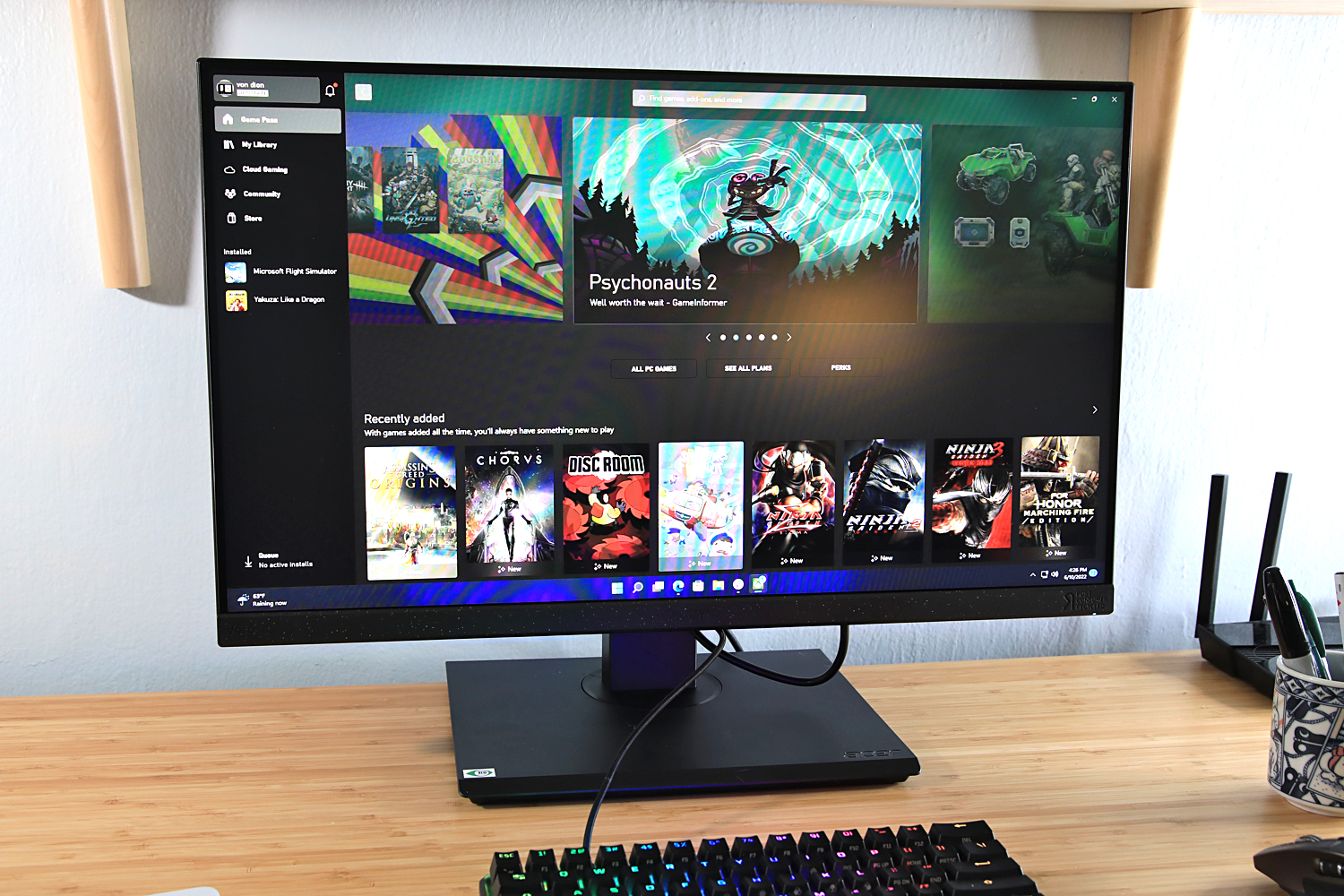
Pros
- Good contrast ratio
- Solid build quality
- Accurate, realistic color
- Uses recyclable plastics, packaging also recyclable
Cons
- Below-average sharpness
- Limited color gamut
- No single standout feature
Concerned about the ecological impact of your home office? You should be. Global E-waste is currently estimated at 53.6 megatons per year and, of course, it’s growing. Acer’s Vero BR277 isn’t going to solve this problem on its own—but it tries.
The Acer Vero BR277, like other Acer Vero products, is partially built from Post-Consumer Recycled Plastics. Despite what you may think, these plastics feel robust. They also have a unique flecked look that stands out from other, less visually interesting designs.
How the monitor is built wouldn’t matter if it was junk—thankfully, it’s quite good. This is a 27-inch 1080p monitor with a respectable maximum brightness of just over 300 nits. The monitor’s color gamut is a bit limited at just 97 precent of sRGB, but it scores well in color accuracy and contrast. The result? Bright, pleasant, realistic image quality.
The monitor has an ergonomic stand that adjusts for height, swivel, and tilt. It also supports AMD FreeSync for smooth gaming and has a maximum refresh of 75Hz.
Pricing is competitive. The monitor originally released at an MSRP of $249.99 but can now be found as low as $169.99. That’s a great price for a home office monitor with good image quality and a height-adjustable stand. Acer also has a 24-inch model, which is even less expensive at $129.99.
Read our full
Review Acer Vero BR277
What to look for in a home office monitor
A great home office monitor should have a high maximum brightness, great image clarity, and vivid color. A height adjustable stand is preferable, as it helps with ergonomics, and a wide range of connectivity is useful for connecting multiple devices.
Resolution matters, but 1080p is still fine
4K is the best resolution in most situations, as it provides a sharper image and can make small fonts easier to read. This remains a premium option, however: Most 4K monitors are still above $300. A 27-inch 4K monitor has a pixel density of 163 pixels per inch.
The less well-known 1440p resolution (2560×1440) is a good option for mid-range monitors. It’s not quite as sharp as 4K, but it’s a noticeable upgrade over 1080p. A 27-inch 1440p monitor has a pixel density of 108 pixels per inch.
1080p resolution remains a good pick for budget monitors. It’s not nearly as sharp as 4K, so video may look a bit soft and small fonts may be harder to read, but it’s still adequate for hundreds of home office tasks. A 27-inch 1080p monitor has a pixel density of 81 pixels per inch.
When it comes to brightness, more is more
Brightness is a key trait for a home office monitor.
An office monitor doesn’t need to be bright to look usable: 200 nits is fine. However, a home office is likely to be brighter and to have less light control than a corporate cubical. A maximum brightness of 300 nits, or better, is ideal. You can always turn the brightness down from its maximum if it looks too bright but, of course, the reverse isn’t true.
Make sure you understand connectivity
It’s important to buy a monitor that supports a video output found on your PC. Most desktop computers will offer both DisplayPort and HDMI, while laptops often stick to HDMI. Budget home monitors sometimes support older connections, such as VGA and DVI, but these are not found on new computers. Our guide to display cables can help you identify the ports on your PC.
You only need one video connection between your PC and your home office monitor, and the type of connection you use isn’t terribly important. HDMI and DisplayPort work equally well for home office use.
USB-C isn’t a must-have, but it’s useful
USB-C with DisplayPort Alternate Mode is a new alternative to HDMI and DisplayPort. It bundles a DisplayPort connection into the familiar USB-C port now used by many devices (and soon to be required by law in Europe).
Some high-end laptops, like the Dell XPS 13 Plus, only support video output over USB-C. You can still connect a DisplayPort monitor with a USB-C to DisplayPort cable adapter, but this is a clunky solution.
USB-C, unlike HDMI and DisplayPort, can support Power Delivery to charge a connected device. This is useful for thin-and-light laptops, as it makes docking the laptop easier. Some USB-C monitors, like the Dell U3223QE, have built-in USB-C hubs that connect to multiple USB-A ports, ethernet, and DisplayPort-out. Our guide to USB-C hub monitors has the full scoop on these perks.
How we test monitors
PCWorld’s monitor reviews rely on in-depth testing by a team of staff and freelance writers. Our experts spend hundreds of hours testing and comparing monitors to find the best choice for any budget.
We test monitors with a SpyderXElite color calibration tool. This provides objective measurements for brightness, contrast, color accuracy, color temperature, gamma, and color gamut, among other metrics. These objective metrics help us compare dozens of monitors at once and eliminate bias from comparisons.
For all the latest Technology News Click Here
For the latest news and updates, follow us on Google News.
